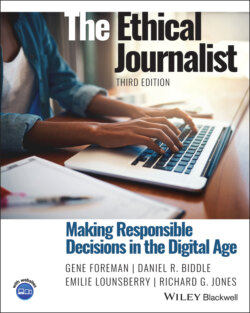Читать книгу The Ethical Journalist - Gene Foreman - Страница 10
Foreword
ОглавлениеBy Philip B. Corbett
The writer is associate managing editor for standards of The New York Times.
It feels like ancient history, but it wasn’t so long ago that our whole job in the newsroom of The New York Times was to put out the print paper once a day. It seemed hard at the time – unforgiving deadlines, lots of stress and pounding on keyboards. Now, looking back, I wonder what we actually did all day. One print edition every 24 hours? Sounds pretty cushy.
Everything’s different now, for The Times and every other news organization. A daily print paper, yes, many newsrooms still do that. But now we also have minute-by-minute digital deadlines, 24 hours a day. Constant social media posting on an ever-expanding range of platforms. Video. Audio. Interactive graphics. Live chats. Newsletters. Every day, it seems, brings a new journalistic tool, and every innovation brings new questions about journalistic standards and ethics.
What’s appropriate for a journalist to post on Twitter, and what’s off limits? Are there different standards for corrections on breaking-news alerts? What are the anonymity rules for podcast interviews? Do reporters always have to identify themselves on Facebook? Are tools like facial-recognition technology fair game for journalists? Does Google change how we think about archived stories?
It can feel deeply disorienting. But even as the journalistic ground shifts under our feet, it’s crucial to remember this: The most important parts of our work are not changing at all.
Get the facts right. Be fair and empathetic. Guard your independence. When it’s time to hit “publish,” tell your readers, viewers and listeners the truth, as best you can.
This book explores those fundamental principles and how to apply them, whether in traditional stories or new formats. You’ll wrestle with how to balance a subject’s right to privacy with a reader’s right to know. You’ll think hard about whether your personal views might skew your reporting, and how to cultivate sources while guarding your independence. You’ll consider whether your empathy as a person ever conflicts with your obligations as a journalist. And you’ll confront the complex challenges of covering a diverse society with sensitivity and rigor.
The basic principles – accuracy, fairness, independence – are clear. But the case studies in this book demonstrate something I’ve learned and relearned during nearly four decades in journalism. For many of the most important decisions we make, there’s no single, obvious right answer. Even when we agree on the principles, it’s not always clear how they apply to a messy set of circumstances. There are hard calls, gray areas and difficult balances to strike. This textbook doesn’t provide a convenient list of the right answers to all the problems you’ll face. It helps you learn how to think about those problems.
As you grapple with these issues of journalistic standards and ethics, here’s one simple tactic I often find helpful. Imagine a thoughtful reader – fair-minded and reasonable, but tough and skeptical as well. Not your mother, who’ll applaud everything you do. And not a bad-faith critic whose whole goal is to undermine your efforts. But a reader who cares about the topic you’re covering and wants you to get it right.
Now imagine that this fair-minded but skeptical reader knows everything about how you reported, wrote or edited the story you’re working on. Heard the very conversations you’re having with your editor. Saw what you chose to put in and what you left out. Knew how you dealt with your sources. Watched while you or your colleagues decided what picture to use, what anecdote to lead with, what headline to write.
What if you walked that reader through everything you did and explained every decision you made? Would the reader trust your journalism more, or less? If there are some things about your work that you’d rather a reader not know – well, maybe you should think again about that part of the process.
Sometimes this thoughtful-reader test isn’t just a theoretical exercise. One big step forward in journalistic practices in recent years is the trend toward transparency – a greater willingness to show our work and explain how we did it. It’s increasingly common for reporters to lay out how many sources they interviewed, how they first learned about a crucial document, what elements of a story they still haven’t nailed down. But even if you don’t put those details into a story, imagine what you would say to a reader who wanted to know.
Earning and keeping that reader’s trust is the ultimate goal of all our ethics guidelines. This book will help prepare you for that challenge.
